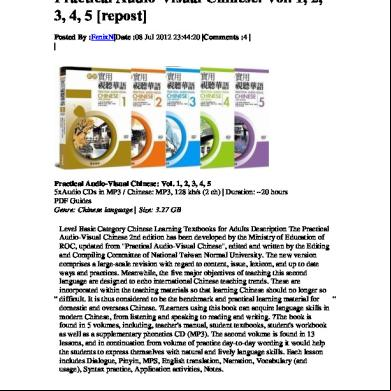Colourimetry Practical 1yr2i
This document was ed by and they confirmed that they have the permission to share it. If you are author or own the copyright of this book, please report to us by using this report form. Report 3b7i
Overview 3e4r5l
& View Colourimetry Practical as PDF for free.
More details w3441
- Words: 920
- Pages: 6
Running Head: CHEMISTRY
1
Chemistry Student Name Instructor Name Date
CHEMISTRY
2 Chemistry
Colourimetry Colorimetery is a chemical method used to determine the concentration of a colored compounds in a solution or it’s a technique that measures the concentration of a known constituent of a solution by comparison with colors of a standard solution of that constituent (Colorimetry 1998). It can also be determined as the physical intensity which is used to determine the concentration of a colored compound in a solution. The device used to measure the concentration of a colored compound is called Colorimeter. It is a light-sensitive device and work by measuring the transmittance and absorbing of light ing through a liquid sample. It measures the intensity or concentration of the color that develops upon introducing a specific reagent into a solution. Two types of Colorimeters used to measure the concentration – One is Densitometers and the other is Color photometers (Sapan, Lundblad and Price 1999). Densitometer: It measures the intensity of primary colors. Color photometers: It measures the color reflection and transmittance. Colorimeter has three components, these are a light source, a cuvette containing the sample solution and a photocell attached for detecting the light that through the solution. It is also equipped with either colored filters or specific LEDs to generate color. The output is displayed by an analog or digital meter in of absorbance or transmittance in Colorimeter. Principle of Colorimetry
CHEMISTRY
3
According to Beer Lambert’s Law, ‘Absorption of light transmitted through the medium is directly proportional to the concentration of the medium.’ The principle of colorimeter is based on this law. Working of the device is that a beam of light with a specific wavelength through a series of lenses is ed through a solution, which navigates the colored light to the measuring device. It analyses the color of the solution compared to an existing standard. Calculation of absorbance or percentage transmittance is calculated by the microprocessor. More light will be absorbed if the concentration of the solution is greater, which can be identified by measuring the difference between the amount of light at its origin and that after ing the solution. Several sample solutions of a known concentration are first prepared and tested, in order to determine the concentration of an unknown sample. The concentrations are then plotted on a graph against absorbance that generates a calibration curve. The results of the unknown sample are compared to that of the known sample on the curve to measure the concentration. Method 1. A 0.002 mol. /L paracetamol solution has been prepared to use as a stock solution for your practical. 2. To each of 7 test tubes add 1.0 ml HCl (6 mol. /L) and 2 ml sodium nitrite solution (10%; freshly prepared and pre-made). 3. Label the tubes carefully and then add stock paracetamol solution and water to the tubes as indicated.
CHEMISTRY
4
Tube
1
2
3
4
5
6
7
Paracetamol
0
0.2
0.4
0.6
0.8
1.0
0
(ml) Water (ml)
1.0
0.8
0.6
0.4
0.2
0
0
Additionally, add 1.0 ml of the test solution (unknown concentration) to tube 7. 4. Mix all the tubes thoroughly and allow them to stand for 2 minutes. 5. Add 2 ml ammonium sulphamate (15%) drop wise to each tube. Do this carefully to avoid frothing. 6. Add 2.5 ml sodium hydroxide (25%) to each tube and mix for 15 seconds. 7. Allow the tubes to stand for 2 minutes to allow any bubbles to disperse. Gently tapping the side of the tube may help in this respect. 8. Measure the absorbance of tubes 2-7 at 430 nm using tube 1 as the blank. If bubbles form in the cuvettes these should be dispersed with a glass rod as they will lead to inaccurate colorimeter readings. Result Tube no 1 2 3 4 5 6 7
Concentration 0 0.0004 0.0008 0.0012 0.0016 0.002 Unknown
Absorbance 0 0.133 0.302 0.42 0.535 0.691 0.325
CHEMISTRY
5 0.8 0.7 0.6
f(x) = 0.08x + 0.01 R² = 0.59
0.5 Absorbance
0.4 0.3
Linear ()
0.2 0.1 0 0
1
2
3
4
5
6
7
8
Concentration
Discussion Many analytical methods are used to determine plasma concentration of Paracetamol in biological fluids, Colorimetry with chemical derivatization is one of them. It is essential to determine/measure the concentration of Paracetamol in biological fluids because of the need to acquire antidote therapy, driven by the needs of clinical toxicology requiring the rapid, reliable and highly specific estimation of Paracetamol in plasma samples. However, paracetamol is a widely available over the counter drug and cheap to buy and is a common drug used in overdose. It has an excellent analgesic and antipyretic properties. Due to these sufficient reasons and its use in overdoses, plasma concentration in vivo is studied and measured (Shihana, et al. 2010).
CHEMISTRY
6
References Acetanilides: Advances in Research and Application: 2011 Edition. Atlanta: ScholarlyEditions, 2012. Colorimetry. July 20, 1998. https://www.britannica.com/science/colorimetry (accessed February 23, 2017). Patel, HV, and DJ Morton. "Specificity of a colorimetric paracetamol assay technique for use in cases of overdose." Journal of Clinical Pharmacy and Therapeutics 13, no. 3 (1988): 233-238. Rainsford, Kim D. Aspirin and Related Drugs. Boca Raton: CRC Press, 2016. Sapan, CV, RL Lundblad, and NC Price. "Colorimetric protein assay techniques." Biotechnology and Applied Biochemistry, 1999: 99-108. Shihana, Fathima, Dhammika Menike Dissanayake, Paul Ivor Dargan, and Andrew Hamilton Dawson. "A modified low-cost colorimetric method for paracetamol (acetaminophen) measurement in plasma." Clinical Toxicology 48, no. 1 (2010): 42-46.
1
Chemistry Student Name Instructor Name Date
CHEMISTRY
2 Chemistry
Colourimetry Colorimetery is a chemical method used to determine the concentration of a colored compounds in a solution or it’s a technique that measures the concentration of a known constituent of a solution by comparison with colors of a standard solution of that constituent (Colorimetry 1998). It can also be determined as the physical intensity which is used to determine the concentration of a colored compound in a solution. The device used to measure the concentration of a colored compound is called Colorimeter. It is a light-sensitive device and work by measuring the transmittance and absorbing of light ing through a liquid sample. It measures the intensity or concentration of the color that develops upon introducing a specific reagent into a solution. Two types of Colorimeters used to measure the concentration – One is Densitometers and the other is Color photometers (Sapan, Lundblad and Price 1999). Densitometer: It measures the intensity of primary colors. Color photometers: It measures the color reflection and transmittance. Colorimeter has three components, these are a light source, a cuvette containing the sample solution and a photocell attached for detecting the light that through the solution. It is also equipped with either colored filters or specific LEDs to generate color. The output is displayed by an analog or digital meter in of absorbance or transmittance in Colorimeter. Principle of Colorimetry
CHEMISTRY
3
According to Beer Lambert’s Law, ‘Absorption of light transmitted through the medium is directly proportional to the concentration of the medium.’ The principle of colorimeter is based on this law. Working of the device is that a beam of light with a specific wavelength through a series of lenses is ed through a solution, which navigates the colored light to the measuring device. It analyses the color of the solution compared to an existing standard. Calculation of absorbance or percentage transmittance is calculated by the microprocessor. More light will be absorbed if the concentration of the solution is greater, which can be identified by measuring the difference between the amount of light at its origin and that after ing the solution. Several sample solutions of a known concentration are first prepared and tested, in order to determine the concentration of an unknown sample. The concentrations are then plotted on a graph against absorbance that generates a calibration curve. The results of the unknown sample are compared to that of the known sample on the curve to measure the concentration. Method 1. A 0.002 mol. /L paracetamol solution has been prepared to use as a stock solution for your practical. 2. To each of 7 test tubes add 1.0 ml HCl (6 mol. /L) and 2 ml sodium nitrite solution (10%; freshly prepared and pre-made). 3. Label the tubes carefully and then add stock paracetamol solution and water to the tubes as indicated.
CHEMISTRY
4
Tube
1
2
3
4
5
6
7
Paracetamol
0
0.2
0.4
0.6
0.8
1.0
0
(ml) Water (ml)
1.0
0.8
0.6
0.4
0.2
0
0
Additionally, add 1.0 ml of the test solution (unknown concentration) to tube 7. 4. Mix all the tubes thoroughly and allow them to stand for 2 minutes. 5. Add 2 ml ammonium sulphamate (15%) drop wise to each tube. Do this carefully to avoid frothing. 6. Add 2.5 ml sodium hydroxide (25%) to each tube and mix for 15 seconds. 7. Allow the tubes to stand for 2 minutes to allow any bubbles to disperse. Gently tapping the side of the tube may help in this respect. 8. Measure the absorbance of tubes 2-7 at 430 nm using tube 1 as the blank. If bubbles form in the cuvettes these should be dispersed with a glass rod as they will lead to inaccurate colorimeter readings. Result Tube no 1 2 3 4 5 6 7
Concentration 0 0.0004 0.0008 0.0012 0.0016 0.002 Unknown
Absorbance 0 0.133 0.302 0.42 0.535 0.691 0.325
CHEMISTRY
5 0.8 0.7 0.6
f(x) = 0.08x + 0.01 R² = 0.59
0.5 Absorbance
0.4 0.3
Linear ()
0.2 0.1 0 0
1
2
3
4
5
6
7
8
Concentration
Discussion Many analytical methods are used to determine plasma concentration of Paracetamol in biological fluids, Colorimetry with chemical derivatization is one of them. It is essential to determine/measure the concentration of Paracetamol in biological fluids because of the need to acquire antidote therapy, driven by the needs of clinical toxicology requiring the rapid, reliable and highly specific estimation of Paracetamol in plasma samples. However, paracetamol is a widely available over the counter drug and cheap to buy and is a common drug used in overdose. It has an excellent analgesic and antipyretic properties. Due to these sufficient reasons and its use in overdoses, plasma concentration in vivo is studied and measured (Shihana, et al. 2010).
CHEMISTRY
6
References Acetanilides: Advances in Research and Application: 2011 Edition. Atlanta: ScholarlyEditions, 2012. Colorimetry. July 20, 1998. https://www.britannica.com/science/colorimetry (accessed February 23, 2017). Patel, HV, and DJ Morton. "Specificity of a colorimetric paracetamol assay technique for use in cases of overdose." Journal of Clinical Pharmacy and Therapeutics 13, no. 3 (1988): 233-238. Rainsford, Kim D. Aspirin and Related Drugs. Boca Raton: CRC Press, 2016. Sapan, CV, RL Lundblad, and NC Price. "Colorimetric protein assay techniques." Biotechnology and Applied Biochemistry, 1999: 99-108. Shihana, Fathima, Dhammika Menike Dissanayake, Paul Ivor Dargan, and Andrew Hamilton Dawson. "A modified low-cost colorimetric method for paracetamol (acetaminophen) measurement in plasma." Clinical Toxicology 48, no. 1 (2010): 42-46.










